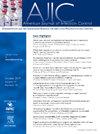Observing is influencing: How hand disinfection compliance observations affect hand disinfection rates; specifics derived from an electronic monitoring system
IF 2.4
3区 医学
Q2 INFECTIOUS DISEASES
引用次数: 0
Abstract
Background
Monitoring hand disinfection (HD) with direct observation is considered the gold standard but is flawed by the Hawthorne effect (HE). In our project in a German university hospital, we quantified the HE and evaluated possible room-specific differences.
Methods
Data were collected on an intensive care unit (ICU), an intermediate care unit, and a normal ward (NW) each categorized into “patient,” “utility/waste,” and “other” rooms. While dispensers were monitored by sensors of a full-time active electronic monitoring system, the infection prevention and control staff performed step-by-step observations according to the World Health Organization “5 moments.” Periods with and without direct observations were compared regarding the number of HDs performed per patient day (HD/PD) using descriptive evaluation and a linear mixed model.
Results
The HE was detected in “patient” rooms on the NW and ICU (+ 31.4%, + 27.4% HD/PD; both P < .01) during observation periods. Opposite effects, expressed by significant decreases in HD/PD during observations, occurred in “utility/waste” rooms on the NW (−57.7%), intermediate care unit (−99.4%), and ICU (−32.9%).
Conclusions
In our setting, the HE varied considerably between wards and room types. As HE occurred in patient rooms, the usual HD compliance during patient care may be lower than directly observed.
观察即影响:手消毒依从性观察对手消毒率的影响来自电子监控系统的细节。
背景:直接观察监测手消毒(HD)被认为是金标准,但霍桑效应(HE)存在缺陷。在我们在德国大学医院的项目中,我们量化了HE并评估了可能的房间特异性差异。方法:收集重症监护病房(ICU)、中级监护病房(IMC)和普通病房(NW)的数据,每个病房分为“病人”、“公用设施/废物”和“其他”房间。在由一个全职主动电子监测系统(EMS)的传感器监测售货机的同时,感染预防和控制工作人员根据世卫组织的“五个时刻”进行了逐步观察。使用描述性评估和线性混合模型比较有直接观察和没有直接观察的期间,每个患者每天进行的HD/PD数量。结果:NW、ICU病房HE检出率分别为+31.4%、+27.4%;p < 0.01)。相反的效果表现为观察期间HD/PD显著下降,在NW(-57.7%)、IMC(-99.4%)和ICU(-32.9%)的“公用事业/废物”室发生。讨论与结论:在我们的设置中,病房和房间类型之间的HE差异很大。由于HE发生在病房,患者护理期间HD的依从性可能比直接观察到的要低。
本文章由计算机程序翻译,如有差异,请以英文原文为准。
求助全文
约1分钟内获得全文
求助全文
来源期刊
CiteScore
7.40
自引率
4.10%
发文量
479
审稿时长
24 days
期刊介绍:
AJIC covers key topics and issues in infection control and epidemiology. Infection control professionals, including physicians, nurses, and epidemiologists, rely on AJIC for peer-reviewed articles covering clinical topics as well as original research. As the official publication of the Association for Professionals in Infection Control and Epidemiology (APIC)

 求助内容:
求助内容: 应助结果提醒方式:
应助结果提醒方式:


